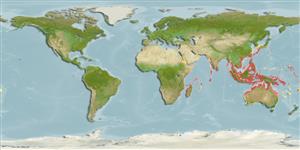Elasmobranquios (tiburones y rayas) (sharks and rays) >
Carcharhiniformes (Ground sharks) >
Atelomycteridae (Coloured catsharks)
Etymology: Atelomycterus: ateles (Gr.), imperfect, unfilled or exempt; mycteros (Gr.), nostril, referring to lack of posterior nasal valve (See ETYFish); marmoratus: Latin for marbled, referring to white blotches over large black spots and bars (See ETYFish).
Environment: milieu / climate zone / depth range / distribution range
Ecología
marino asociado a arrecife. Tropical
Indo-West Pacific: Pakistan and India to Malaysia, Singapore, Indonesia, New Guinea, Thailand, Viet Nam, the Philippines, southern China; north to Japan.
Length at first maturity / Tamaño / Peso / Age
Maturity: Lm ?, range 49 - ? cm
Max length : 70.0 cm TL macho / no sexado; (Ref. 244)
Espinas dorsales (total) : 0; Espinas anales: 0. Saddle markings obsolete, light grey and white spots outlined by large black spots, bars and lines (Ref. 11146).
A common but little-known inshore shark found on coral reefs and though to inhabit crevices and holes on reefs (Ref. 11146). Oviparous (Ref. 50449). Caught occasionally by various fisheries operating over coral reefs and probably adversely affected by dynamite fishing (Ref.58048). Utilized fresh and dried-salted for food or processed for fishmeal and oil (Ref. 244).
Life cycle and mating behavior
Madurez | Reproducción | Puesta | Huevos | Fecundidad | Larva
Oviparous, with single egg-cases laid per oviduct (Ref. 244). Embryos feed solely on yolk (Ref. 50449).
Compagno, L.J.V., 1984. FAO Species Catalogue. Vol. 4. Sharks of the world. An annotated and illustrated catalogue of shark species known to date. Part 2 - Carcharhiniformes. FAO Fish. Synop. 125(4/2):251-655. Rome: FAO. (Ref. 244)
IUCN Red List Status (Ref. 130435: Version 2024-2)
Human uses
Pesquerías: pesquerías de subsistencia
Herramientas
Special reports
Download XML
Fuentes de Internet
Estimates based on models
Preferred temperature (Ref.
123201): 25.3 - 29.3, mean 28.6 °C (based on 2581 cells).
Phylogenetic diversity index (Ref.
82804): PD
50 = 0.5156 [Uniqueness, from 0.5 = low to 2.0 = high].
Bayesian length-weight: a=0.00389 (0.00180 - 0.00842), b=3.12 (2.94 - 3.30), in cm total length, based on all LWR estimates for this body shape (Ref.
93245).
Nivel trófico (Ref.
69278): 3.8 ±0.3 se; based on size and trophs of closest relatives
Resiliencia (Ref.
120179): Bajo, población duplicada en un tiempo mínimo de 4.5-14 años (Fec assumed to be <100).
Fishing Vulnerability (Ref.
59153): Moderate to high vulnerability (48 of 100).
Nutrients (Ref.
124155): Calcium = 12.7 [3.0, 68.5] mg/100g; Iron = 0.425 [0.109, 1.193] mg/100g; Protein = 18.4 [15.1, 21.5] %; Omega3 = 0.0716 [, ] g/100g; Selenium = 24.8 [7.6, 70.3] μg/100g; VitaminA = 102 [38, 264] μg/100g; Zinc = 0.841 [0.396, 1.722] mg/100g (wet weight);
